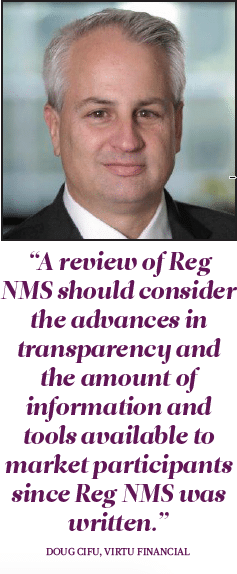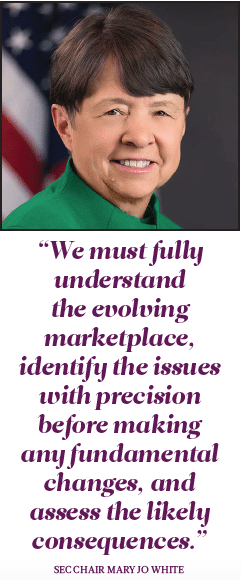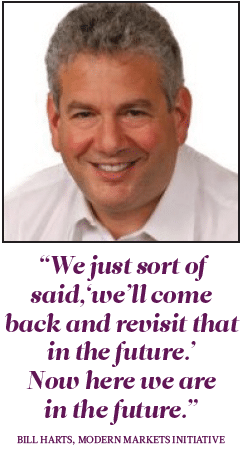
LANDMARK EQUITY-MARKET RULESET IS SHOWING ITS AGE; HOW TO UPDATE?
WHEN REGULATION National Market System was established in 2005, George W. Bush was five months into his second term as U.S. President.
Lehman Brothers was reporting record quarterly earnings.
The iPhone didn’t exist.
A lot has changed in 11 years, both in the world at large and in financial markets. So it stands to reason that Reg NMS, the sweeping ruleset that was aimed at modernizing and strengthening equity market structure, has passed its ‘best by’ date.
If the U.S. Securities and Exchange Commission were today tasked with drawing up equity regulations from scratch, it’s safe to say Reg NMS wouldn’t be the end result.
 But though some of its pages are yellowing, the playbook still has its utility, and market participants and observers say the notion of a full scrapping goes too far. That begs the questions of how Reg NMS should be changed.
But though some of its pages are yellowing, the playbook still has its utility, and market participants and observers say the notion of a full scrapping goes too far. That begs the questions of how Reg NMS should be changed.
“It is important that a review of Reg NMS is conducted with an understanding of the diversity of market participants (retail, institutional, professional) and securities (small-/mid-/large-cap, ETPs), and an assessment of how well the current regulations are serving their needs,” said Doug Cifu, chief executive officer of electronic market maker Virtu Financial.
“If the goal is to evaluate the efficacy of our current one-size-fits-all regulation, let’s continue with what the regulators have begun, that is, using a data-driven approach to identify what is working before they make any changes.”
“A review of Reg NMS should consider the advances in transparency and the amount of information and tools available to market participants since Reg NMS was written,” Cifu told Markets Media.
“With these advances, certain market participants now have far greater visibility and insight through their own best execution analysis, which in turn enables them to make better routing decisions. We believe that, where possible, prescriptive regulation should make way for principles-based regulation, which tends to be more ‘future-proof’.”
COMPETITION FOSTERED
Reg NMS sought to improve the execution experience of investors by opening up the trading-venue business — which had been dominated by incumbents New York Stock Exchange and Nasdaq — to competition.
The idea was that competition among markets would promote fair and efficient price formation. The overarching aim of fostering competition was achieved, in a big way.
When IEX transitioned to an exchange in August, it became the 13th U.S. equity exchange.
Bats Global Markets has emerged as a formidable competitor to NYSE and Nasdaq, as the operator now executes about one-fifth of all exchange-traded volume.
Offexchange, the universe of alternative trading systems has swelled to more than 40, some of which are established players operated by the biggest Wall Street banks.
So investors have plenty of choice.
And a more competitive landscape presumably has kept the trading venues themselves on their toes, resulting in improved performance.
Those are a couple of the high-level pros of Reg NMS.
On the con side, market participants and observers most often cite complexity and fragmentation — which gets back to the existential question around the ruleset.
“While the equity marketplace has certainly grown more complex since the creation and implementation of Reg NMS, a complete overhaul of the rules governing equity markets is unnecessary and fraught with unintended consequences,” said Steve Komon, senior passive equities portfolio manager and senior trader at Colorado Public Employees’ Retirement Association, a $45 billion pension plan.
“Tweaking or adding to the regulation is a more reasonable, and potentially attainable, option.” “Any changes to Reg NMS should consider the costs and benefits of the fragmented marketplace,” Komon told Markets Media. “Are the various exchanges providing a truly differentiated offering? If so, this legitimate competition should be fostered. New exchanges that mimic existing choices, however, only add complexity rather than unique value to investors.”
 One flashpoint within Reg NMS is the Order Protection Rule, or NMS Rule 611, which requires traders to transact on the trading venue with the best price; reliability and speed of execution are secondary considerations.
One flashpoint within Reg NMS is the Order Protection Rule, or NMS Rule 611, which requires traders to transact on the trading venue with the best price; reliability and speed of execution are secondary considerations.
The OPR only protects quotes at the top of the book, which can result in a portion of an order being executed at an inferior price if one market’s bench players are better than another market’s starter.
“Given the proliferation of exchanges, which are of varying depth, does this rule need to be adjusted?” Komon asked. “Maybe larger blocks need different rules than ‘best displayed price’. Perhaps market-based solutions like IEX will alleviate some of the issues for investors trying to trade larger orders, such as quote fading.”
The SEC is aware of Reg NMS’s age.
In a June 2016 speech, SEC Chair Mary Jo White noted that Reg NMS was the culmination of a five-year effort, and she called it a “landmark body of rules that govern all aspects of today’s national market system.”
But time marches on.
“The Commission is now in the midst of another significant phase of market structure review, as technology advancements continue to accelerate the pace of change in how orders are generated and executed,” White said. “It is critical that we, as regulators, keep pace with these changes with a keen focus on the fundamentals driving them. We must fully understand the evolving marketplace, identify the issues with precision before making any fundamental changes, and assess the likely consequences that may follow.”
Reg NMS was meant to consolidate many of the disjointed rules set forth in 1975, when the SEC first facilitated a national market system. Wall Street wasn’t thrilled to have the task of reading, understanding and complying with the 371-page opus, but the industry adapted, and the equity market enjoyed some of its best years (in terms of commissions, trading volume and profits) shortly after Reg NMS was adopted.
Stacey Cunningham, chief operating officer at IntercontinentalExchange’s NYSE Group, told Markets Media that the exchange operator supports Reg NMS reform.
“We strongly believe that any changes to equity market regulation should be focused on prioritizing displayed liquidity and reducing complexity for market participants and investors,” she said.
There will be disagreements among market participants, market operators, and regulators as to how Reg NMS should be changed. One area of consensus is that the SEC’s task is a substantial one, which will take years to complete.
YESTERDAY’S TOMORROW
“There needs to be a very rigorous, deep dive into what do markets need today, and how are those needs not being handled by existing regulations,” said Bill Harts, a long-time trader and currently chief executive officer at Modern Markets Initiative, an high-frequency trading advocacy group.
 Harts worked in corporate strategy for Nasdaq when Reg NMS was being developed, and he was in electronic trading at Bank of America when the ruleset was enacted.
Harts worked in corporate strategy for Nasdaq when Reg NMS was being developed, and he was in electronic trading at Bank of America when the ruleset was enacted.
He recalls from those front-row seats a general acknowledgement that Reg NMS was not perfect and some aspects would need to be returned to, especially given the rapid evolution of equity markets.
“We just sort of said, ‘we’ll come back and revisit that in the future’,” Harts said. “Now here we are in the future.” Reg NMS’s influence has extended beyond U.S. market centers. “The rest of the world is moving towards a Reg NMS framework,” said James Angel, associate professor at Georgetown University’s McDonough School of Business.
Europe is trying to harmonize banks, and there have been similar efforts in Canada, Australia, and Japan, Angel noted.
“Regulatory thinking has gone towards a Reg NMS world.” According to Angel, Reg NMS forced exchanges to go electronic, created interconnections between exchanges and forced traders to execute at the best price.
It ushered in the era of the penny tick across all NMS securities, and it also brought many other sub rules, such as Rule 605 and 606.
But as with any sweeping regulation that’s more than a decade old, there are problem areas.
“If I had to put my finger on probably the most important thing that people should look at right now, it would be the prohibition against locked markets,” Modern Markets’ Harts said. “It was created in a time when people quoted by hand. It was created to solve a problem that doesn’t exist any longer.”
A New York-based trader opined that the use of protected quotes by public exchanges should be abolished.
“Why is it I should be forced to trade on an exchange if I’d rather not?” the trader asked. “Even if the exchange has the best price, why should I be forced to route there if I don’t want to? That is one thing I’d want carefully examined.”
Fixing Reg NMS, according to many, will require a full-up, completely thorough examination of the regulation and market structure.
This would need to be undertaken at the highest levels — not by trade groups or the self-regulatory organizations, but by the SEC itself. Already faced with budget constraints and personnel issues, the financial markets’ top regulator would have to orchestrate this entire review and reform process, something Wall Street says won’t take months.
Harts declined to speculate on the length of the process but did say fixing Reg NMS needs to be a formal process that probably will take a significant amount of time.
He recalled that back in 1997, the SEC put together a 500-page report called “Markets 2000” which was a concept-type paper that examined 21st-century trading. This type of magnum opus might be in order to diagnose and repair NMS.
“Look, let’s get it right this time,” Harts said. “Let’s not try to rush something through only to find ourselves having debates about 1 millisecond versus 300 microseconds versus whatever just a few years down the road. Let’s get it right once and for all.”
But Georgetown’s Angel said that the SEC can be paralyzed by fear of judicial action as a result of its changing the extant system.
“The SEC is afraid to do anything, reasonable or fast, and so all of their rule-makings are extraordinary slow,” Angel said. The SEC would rather rule-make by enforcement actions when an egregious infraction occurs, or lean on the Self-Regulatory Organizations, such as the exchanges or Finra, to work out of the spotlight and police the markets quietly from within.
“Finra and the exchanges don’t have to go through the same level of legal scrutiny with cost benefit analysis as the SEC, so they can basically do what they want,” Angel said. “I look at the SROs as delegated enforcement organizations.”
Harts was optimistic on the outlook for true reform.
“I have a lot of sympathy for SEC staff — I think they get a tremendous amount of pressure from different constituencies and different market participants,” he said. “It must be hard for them to arbitrate amongst all the noise. I think what they need to do is put the process in motion and then get the best minds in the industry to weigh in on the different aspects of it.”
REG NMS 1.5?
“The legacy of Reg NMS is that it brought market structure to the forefront and it was successful in bringing about competition, both dark and lit,” said Tal Cohen, senior vice president of U.S. equities at Nasdaq. “It absolutely facilitated the growth of electronic trading.”
“It has served large-cap companies well. But on the other hand, small-cap and emerging growth companies got somewhat left behind,” Cohen added. “It did introduce some complexity and some systemic risk that we’re still trying to work through. If you look at it as a whole, it was a positive. We have a very efficient market. Retail has never had it better. The key was that it brought about competition.”
Drafting Reg NMS 2.0 won’t be easy.
A workable compromise may more closely resemble Reg NMS 1.5, or even Reg NMS 1.25.
“Tweaking, enhancing, or overhauling Reg NMS requires achieving a broad consensus among disparate market participants,” said Komon of Colorado PERA. “Given the wide range of perspective on any potential changes, incremental improvement seems the more realistic goal.”
“In addition, we must consider whether any new system truly improves the marketplace compared to Reg NMS, or simply trades one set of issues for another,” Komon continued. “No easy fix will satisfy all market participants, so finding common ground on improving current rules is the best course of action.”
TABLE OF CONTENTS
Editor’s Note
When was the last time the functioning of equity markets made news?
Dear Fellow STA Member
A note from outgoing Chairman Jon Schneider.
Shining Light on Dark Pools
Venue operators face scrutiny into how they conduct business.
November 8 Looms Large
Clinton or Trump? In a very unconventional election, the Republican candidate is the one feared by Wall Street.
EMSAC Comes of Age
Market structure advisory group ramps up activity, keeps SEC busy with recommendations.
CAT Moves Forward Slowly
The industry is on board with the concept but troubled by some details.
Equity Exchanges Evolve
Competition, fragmentation, and technology are among primary themes for listed-trading venues.
Market Structure Insights
Assessing the Disclose-and-Review approach to best execution. By Andrew Upward, Weeden
Spotlight on HFT Dims
High-frequency trading may not have quite gained acceptance — but at least the pitchforks have been put aside.
T+2 Draws Closer to Reality
But will new technologies complicate the migration?
Maker-Taker Under the Microscope
Has the nearly 20-year-old exchange pricing model outlived its usefulness?
Re-Imagining Reg NMS
Landmark equity-market ruleset is showing its age; how to update?
Options Auctions Vex Market Makers
Sidelines transactions diminish already-challenged displayed liquidity.
The Market Data Battleground
Data fees are ridiculously expensive… at least that’s what the brokers say.
